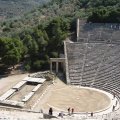EPIDAURUS SANCTUARY ARCHAEOLOGICAL SITE
Unesco site and ancient sanctuary renowned for its theater ( century BC), the finest and best-preserved in antiquity.
Renowned for its theater, the archaeological site of the "Sanctuary of Asclepius in Epidaurus" (Αρχαιολογικός Χώρος Ασκληπιείου Επιδαύρου/Archaiologikos Choros Asklipiiou Epidavrou) has been a Unesco World Heritage Site since 1988. Beneath Mount Kynortion (686 m above sea level) and covering 1,400 ha, lie the remains of a complex that belonged to the city of Epidaurus (15 km to the east). It was not only a place of worship dedicated to the god of medicine Asclepius, but also a health center, the oldest sanatorium known to date. The first building was a Mycenaean temple (16th century BC) erected on a hill in honor of a healing goddess. Around the 8th century BC, the same hill was the site of a temple dedicated to Apollo Maleatas, here honored as the god of Purification and Healing. Its remains (currently under construction) are located 2 km east of the site entrance.
Miracles and games of Asclepius. In the 6th century BC, a new cult developed: that of Asclepius. Epidaurus became the main asclepion (sanctuary of Asclepius) in the Greek world. The "miraculous" cures attributed to the god, the advice given by the priests and the treatments provided by doctors attracted pilgrims and patients from all over the Mediterranean for twelve centuries. The sanctuary also owed its fame to the Asclepian Games: from the5th century BC onwards, competitions were held every four years in honour of Asclepius, with sporting events (in the stadium) and musical events (in the theater). The site was sacked by the Heruli in the 3rd century, but the Games continued until 355. Despite a Gothic raid in 395, the sanctuary continued to function. It was abandoned after two earthquakes in 522 and 551.
Fantastic theater. Start your visit at the theater as soon as it opens, to avoid the crowds. Set against a hill, it was built from 330 B.C. It was the most beautiful theater in the Greco-Roman world and is the best preserved. Its gray limestone cavea (hemicycle) extends over a 58 m radius, with 55 rows of tiers divided into 22 sections served by 23 staircases and the diazoma. This horizontal corridor marks the separation between the original section and the upper section added in the 2nd century BC. The capacity then increased from 6,210 to 12,300 spectators. In the center, the 20 m diameter orchestra (stage) hosted singers and dancers from Antiquity, as well as Maria Callas in 1960 and 1961, as part of the Athens-Epidaurus Festival. As for the actors, they performed on the proskénion (stage). The proskénion has now lost its high façade, which was used to set up the scenery and transmit sound to the cavea. Nevertheless, the acoustics remain spectacular: the limestone attenuates the murmur of the audience and amplifies the sounds coming from the orchestra and proskénion. Try it out: if you say a few words in a normal voice in the orchestra, you can hear them clearly from the top of the stands.
Inn, restaurant and stadium. Leaving the theater, the path runs alongside the museum. As this is close to the entrance/exit to the site, it's best to visit it at the end of the route, to be in the shade when the sun reaches its zenith. Behind the museum begins the vast area containing the remains of buildings designed for the rites, care and reception of pilgrims. The first is the katagogion (4th century BC), an inn with 160 rooms. Around 100 m further on are the Greek baths (4th century BC) and the hestiatorion (c. 300 BC). This banqueting hall was the largest building in the sanctuary (70 x 75 m). It was entered from the north via a monumental propylaeum, and included an odeon added in the 2nd or 3rd century AD. The hestiatorion is one of three buildings on the site to undergo anastylosis restoration: with original fragments and modern materials, deliberately in distinct colors. To the west, the stadium (4th century BC) is 180.7 m long. Part of the stands have been preserved, as have the markers that marked the start of the runners.
Ritual zone. To the north-west, the religious zone begins with the small "Egyptian temple" (3rd or 2nd century BC) where Asclepius, Apollo and Hygie (daughter of Asclepius, goddess of Health and Hygiene) were associated with Osiris (life-giving god of the Dead), Isis and Horus/Harpocrates (protectors of mothers and children). Next come the remains of the temples of Artemis (4th century BC) and Asclepius (5th century BC). The latter, in Doric style, housed a chryselephantine statue (made of gold and ivory) by Thrasymedes of Paros in the 4th century BC. The most impressive "temple" is the tholos (4th century BC), a circular building 21.80 m in diameter and 12 m high, where the sacred snakes of Asclepius lived. Its 26 external Doric columns and 14 internal Corinthian columns have undergone a spectacular anastylosis restoration. The same technique was used for some of the columns of the Abaton (4th-3rd centuries BC), a narrow building 70 m long where the incubation rite took place: patients waited here, lying down, to catch a glimpse of Asclepius in their dreams and receive instructions for their cure.
Did you know? This review was written by our professional authors.
Book the Best Activities with Get Your Guide
Members' reviews on EPIDAURUS SANCTUARY ARCHAEOLOGICAL SITE
The ratings and reviews below reflect the subjective opinions of members and not the opinion of The Little Witty.
Find unique Stay Offers with our Partners





Un passage obligé, et n'oubliez pas de faire le test de la voix en vous plaçant au centre de la scène afin d'être entendu par tout le monde!!!
Ruines du premier hôpital connu , quelques instruments de chirurgie du temps d' Asklépios dans le petit musée, on retrouvera la similitude avec les instruments d' aujourd' hui